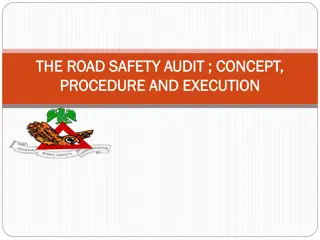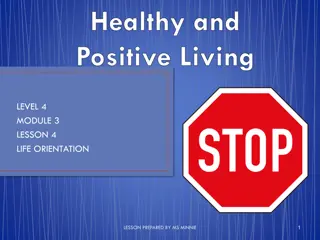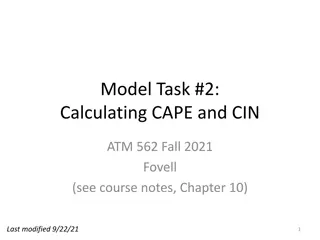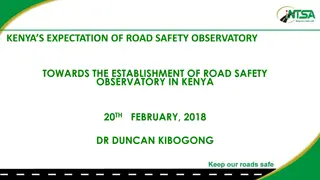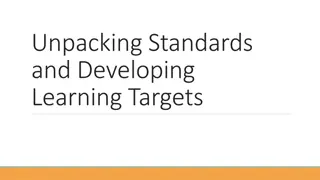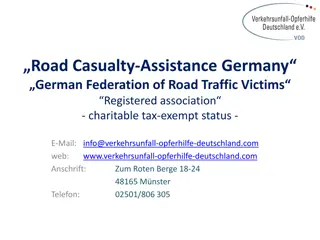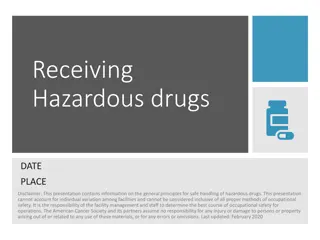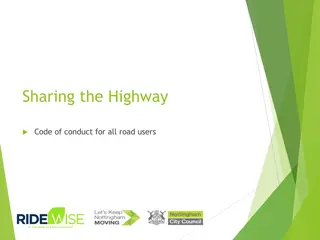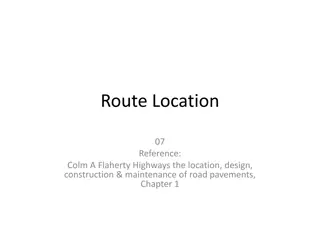Unpacking Road Safety at a District Level: The Case of Cape Town, South Africa
South Africa faces a significant road safety burden, with a focus on Cape Town. Despite initial progress, a plateau in decreasing fatalities necessitates further analysis. This study delves into fatality data from 2011 to 2015 at the local level, comparing absolute numbers and fatality rates per population. Mode of transport is also examined in relation to road fatalities to identify potential interventions. Insights from the study aim to inform targeted road safety measures for Cape Town and beyond.
Download Presentation

Please find below an Image/Link to download the presentation.
The content on the website is provided AS IS for your information and personal use only. It may not be sold, licensed, or shared on other websites without obtaining consent from the author. Download presentation by click this link. If you encounter any issues during the download, it is possible that the publisher has removed the file from their server.
E N D
Presentation Transcript
UNPACKING ROAD SAFETY AT A UNPACKING ROAD SAFETY AT A DISTRICT LEVEL DISTRICT LEVEL THE CASE OF CAPE TOWN, SOUTH AFRICA CAPE TOWN, SOUTH AFRICA THE CASE OF M VANDERSCHUREN, A JANMOHAMMED AND S PHAYANE 11 July 2017
INTRODUCTION INTRODUCTION
Background South Africa is known for its high level of road fatalities. The, so called, road safety burden in the Western Cape, and in particular Cape Town, has been decreasing, due to a prolonged investment in road safety measures. However, the decrease seems to have plateaued and further analysis of available data is required to identify further measures. In this study, fatality data for the years 2011 to 2015 was taken to a local level. Absolute fatalities, as well as the fatalities per 100 000 population, are compared. The mode of transport used is also compared to the level of road fatalities.
Road Fatality per 100 000 Population on the Different Continents Europe (10.3) and North America (11.0) have road fatality rates that are better than the global average (17.0), while continents score below the global average. Africa is the worst performer, with 24.1 fatalities per population. Road Fatalities/100 000 population Europe North America all other Global Australasia Asia 100 000 South America Africa 0 5 10 15 20 25 30 Source: WHO data, 2013
Road Fatality Trends in 182 Low, Middle and High Income Countries Between 2007 and 2010, the number of decreased in 88 countries surveyed by the WHO (2013), suggesting that progress can be made with sufficient national commitment. Of these 88 countries, 42 are high-income countries, 41 are middle-income, while only five were low-income. 87 countries saw increases in the numbers of road traffic deaths over the same period. Many African countries have an increased number of deaths, including South Africa. road fatalities Source: WHO data, 2013 (Trends for 2007 to 2010)
METHODOLOGY METHODOLOGY
Methodology The content of this paper based on the developing work for the Western Cape Government s Road Safety Strategy . Literature review conducted regarding national and international best practices. Road safety issues identified based on first principles (for the human, the road and the environment/province). Road safety status quo established. The part for the Cape Metropole is discussed in this paper. Within the larger project, a road safety action framework was developed using the previous three steps. Feasible measures are modelled to establish a Cost-Benefit ratio, which will lead to a final road safety implementation plan. The latter steps are ongoing and will be reported upon at a later stage.
SOUTH AFRICAN ROAD SAFETY STATUS QUO SOUTH AFRICAN ROAD SAFETY STATUS QUO
a) Mode Distribution In order to examine the mode distributions in different areas of the city, the Traffic Analysis Zones (TAZs) from the NHTS dataset were used. Since the FPS data, contained findings on Gugulethu, it was decided to separate this area from the Mitchells Plain TAZ. The modes examined include; trains, buses, metered taxis, minibus taxis, car passengers, cars, cycling, walking and other modes. interesting Source: NHTS Data, 2013
b) Fatalities per Mode Share Western Cape Cape Town Cyclist 2% Cyclist 3% Driver 17% Driver 21% Motor 7% Pedestrian 46% Pedestrian 58% Motor 5% Passenger 16% Passenger 25% Source: FPS, 2011-2015
b) Fatalities Distribution (2011-2015 annual average) The size of the pie charts in the figure is dependent on the total fatalities, whereby a larger size infers that the total number of fatalities in the area is higher when compared to other areas. The high-income areas (with a large portion of car usage) had high fatalities amongst pedestrians and passengers, although fatalities were lower when compared to other areas within the city. Pedestrians were most affected in low-income areas, where public transport and walking were the most used modes for a large portion of the trips. the total Source: Forensic Pathology Services (FPS) data
c) Mode Distribution To compare the risk of dying due to road crashes, rates per 100 000 population are a useful indication. The results of the analysis are shown in whereby the size of the pie charts in the figure is dependent on the total fatalities. Interesting findings on Gugulethu and, the risk of dying in the area alongside Mitchells Plain is the highest, when compared to other areas of the city. These areas, were also the most affected when considering pedestrian deaths. In addition to these areas, Central Cape Town, Bellville and Durbanville were other areas with a high risk of fatalities. Source: Forensic Pathology Services (FPS) data
Average Annual Fatalities (AAF) Versus AAF per 100 000 Population It is interesting to see that the areas that are identified, using the two different data sets, are often different. It is interesting to see that the fatalities in low-income areas are high in absolute terms, but that the fatalities per 100 000 population are higher in high-income areas, such as Durbanville. Source: FPS, 2011-2015
d) Mode Usage Versus Fatality Rates In order to combine the analysis of mode distribution and fatalities, a percentage difference between the two was performed for each area. A positive difference deduces that the percentage death toll for the road user type is higher when compared to the percentage of the population that prefers that particular mode for their daily trips and vice versa. This analysis was performed for four of the five road user types: driver, passenger, pedestrian and cyclist. In the case of motorcyclists, the mode usage and fatality rates were observed to be very low; hence, no reliable analysis is possible
% Difference : Mode Usage and Fatalities The driver and passenger graphs have an overall percentage, indicating less fatalities compared to the mode use, while the vulnerable (pedestrians and cyclists) have a positive overall indicating a higher fatality rate, compared to the mode use. In almost all areas, the fatality rates for pedestrians are higher than their mode share (by between 15% and 55%), while cyclists are over- exposed, in Sea Simonstown, which are part of the cycling training routes. negative road users percentage, Point and Source: Analysis of users NHTS (2013) and FPS (2011-2015) Figure 10: Percentage Difference between Mode Usage and Fatalities
Identifying Targets based on Data: Pedestrian Pedestrian Average Sea Point Gugulethu Wynberg Simonstown Strand Langa Oostenberg Durbanville Kuilsrivier Area Central Cape Town Somerset West Khayelitsha Mitchells Plain Grassy Park Belgravia Blue Downs Bellville Kraaifontein Atlantis -10.0 0.0 10.0 20.0 30.0 40.0 50.0 60.0 Percentage Fatalites per Percentage Mode Choice Source: Analysis of users NHTS (2013) and FPS (2011-2015)
Identifying Targets based on Data: Cyclist Cyclist Average Sea Point Gugulethu Wynberg Simonstown Strand Langa Oostenberg Durbanville Kuilsrivier Area Central Cape Town Somerset West Khayelitsha Mitchells Plain Grassy Park Belgravia Blue Downs Bellville Kraaifontein Atlantis -4.0 -2.0 0.0 2.0 4.0 6.0 8.0 10.0 12.0 14.0 16.0 Percentage Fatalites per Percentage Mode Choice Source: Analysis of users NHTS (2013) and FPS (2011-2015)
Identifying Targets based on Data: Driver Driver Average Sea Point Gugulethu Wynberg Simonstown Strand Langa Oostenberg Durbanville Kuilsrivier Area Central Cape Town Somerset West Khayelitsha Mitchells Plain Grassy Park Belgravia Blue Downs Bellville Kraaifontein Atlantis -60.0 -50.0 -40.0 -30.0 -20.0 -10.0 0.0 10.0 20.0 Percentage Fatalites per Percentage Mode Choice Source: Analysis of users NHTS (2013) and FPS (2011-2015)
Identifying Targets based on Data: Passenger Passenger Average Sea Point Gugulethu Wynberg Simonstown Strand Langa Oostenberg Durbanville Kuilsrivier Area Central Cape Town Somerset West Khayelitsha Mitchells Plain Grassy Park Belgravia Blue Downs Bellville Kraaifontein Atlantis -60.0 -50.0 -40.0 -30.0 -20.0 -10.0 0.0 10.0 Percentage Fatalites per Percentage Mode Choice Source: Analysis of users NHTS (2013) and FPS (2011-2015)
CONCLUSIONS CONCLUSIONS
Conclusions Car usage was much more prevalent in high-income areas, and public transport or walking, as expected, are more prevalent in low-income areas. The FPS data for the period 2011-2015 was, subsequently, used to determine the average annual fatalities for the same areas. In low-income areas, it was found that pedestrians were the most affected group, while in high-income areas high fatality numbers were seen amongst pedestrians and passengers. The fatalities numbers were converted to average annual fatalities per 100 000 population, to compare the local risk levels. Areas, such as Central Cape Town, Bellville, Blue Downs, Grassy Park and Khayelitsha, that had a high number of average annual fatalities, had low average annual average fatalities per 100 000 population. This signifies that both the average annual fatalities and the average annual fatalities per 100 000 population need to be determined to identify where road safety measures should be implemented. A comparison of the two variables was performed and, interestingly, it was found that the fatalities in low- income areas are high in absolute terms, but that the fatalities per 100 000 population are higher in high-income areas, such as Durbanville.
Conclusions Finally, a percentage difference between mode usage and fatalities was performed for each area for four user types: drivers, passengers, pedestrians and cyclists. The results found that drivers and passengers have an overall negative percentage, indicating less fatalities compared to the mode use, while the vulnerable road users (pedestrians and cyclists) have a positive overall percentage, indicating a higher fatality rate, compared to the mode use. In the case of pedestrians, specifically, the percentage fatality rates were seen to be higher than their percentage mode share by between 15% and 55%. Overall, it can be concluded that the road safety burden in South African cities, including Cape Town, is still very high and that informed road safety measures are required.
EXTRACTS FROM THE WIDER WC ROAD EXTRACTS FROM THE WIDER WC ROAD SAFETY STRATEGY . SAFETY STRATEGY .
Road Safety Issues: the Individual, the Road, the Environment
Cost Benefit Model Being Developed Driver Training Traffic policing * Driver training (i.e. high school curriculum) * Enforcement of substance abuse laws * Enforcement of seat belt usage in front seat * Enforcement of seat belt usage in back seat * Enforcement of child seat usage * Camera enforcement of red light violations * Enforcement of the wearing of bike helmets Vehicle design Heavy vehicle design Vehicle testing Campaign to: * Reduce excess speeding * Reduce substance abuse when driving * Reduce jaywalking * Increase seat belt usage * Increase the wearing of bike helmets Safer Design of Roads Visibility Maintenance Emergency Services * Hospital/clinics * Ambulances Speed Limits * 40km/h * Speed hump/table * Raised crosswalk * Raised intersection * Traffic circle/roundabout * Narrowing * Choker * Mini circle * School erf (combination) Speed enforcement * Lowering speed limit * Enforcing speed limit Grade Seperation * Sink the road * Implementing pedestrian bridges/tunnels Reduction in Fatalities versus Target Benefit/Cost Ratio Fatality Cost Reduction Trend Total Crash Cost Reduction Trend Implementation Cost Trend
Scenario Calculations How often do you make back your investment How fast do you make back your investment Low investment Many lives saved Very high BC Ratio Very quick Break-even Low investment Some lives saved High BC Ratio Quick Break-even Low investment Operational costs Many lives saved High BC Ratio Very quick Break-even
Next step Engagement with local stakeholders to detail implementable measures






